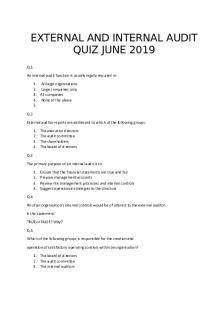Internal AND External - Lecture notes 1 PDF

| Title | Internal AND External - Lecture notes 1 |
|---|---|
| Author | eughyndon velasquez |
| Course | History |
| Institution | Columban College |
| Pages | 2 |
| File Size | 116.8 KB |
| File Type | |
| Total Downloads | 87 |
| Total Views | 168 |
Summary
Difference between Internal and External Criticisms...
Description
1. What are the two (2) ways used for evaluating historical sources? Discuss the difference between Internal Criticism from External Criticism to validate the authenticity if the sources. Historical data is obtained through the method of evaluation from historical data, and is of two kinds: external and internal. External critique is about ensuring the validity or legitimacy of the results. Often known as lower criticism. Historians use references at any stage. Usefulness, durability, objectivity or precision are judged. Sometimes these choices are easily taken, such as by seeing memes. Sometimes the process of analyzing a historical source is more nuanced. Historical analysis asks the question “How did things use to be?”
Historical historians are faced with two main
problems when analyzing documents primary versus secondary sources, and external versus internal criticism. Internal criticism, or constructive feedback, is the researcher’s effort to recover the text’s sense. This is the hermeneutic process in which the scholar interacts with the text's context rather than the document's exterior features. While external criticism is a mechanism whereby historians decide whether a source is credible by testing the source’s authenticity. Internal critique looks at an authenticated source’s credibility after it has been subject to external scrutiny. External Criticism is the aspect of the historical method that deterred the veracity of the source is questioned. The text is sort of like an inmate at a pub. Its authenticity needs to be checked by paleographic and diplomatic critique, where possible. In time and location, it must be localized. It must be known if it remains exactly as its creator left it in its present state. To test its validity, the student must ask himself if it is what appears claim to be or if it is forgery. It is important to interpret the document from any possible perspective. A defining factor in its validity would always be its agreement or disagreement with evidence identified from other genuine sources from the same location and time, or on the same subject. Other signs of genuineness or of its lack are the writer's denial of details which he
could have known and which should have been stated in the text, or the documentation of events which he simply could not have known at the time of writing. A text that has been proved likely to be true by these checks will also be increased in validity by an investigation that will return it to its original state or accentuate the historicity of its reality. Internal Criticism is the element of the historical process that is deterrence. Minimizes the historicity of the evidence in the paper. It does not belong to absolute need to prove the document genuine; even forgeries or documents with truncated truths which contain material available. But before any inference is admissible, it is important to verify the evidence found in the text. The essence of the sources, the experience of the writers, and the factors present at the time of writing must be carefully determined in order to determine the importance of these information. In addition, the evidence supplied by the author or writer have to be firmly identified as having happened exactly as stated. The student or study worker must be imbued with a sincere determination to reach the truth and be oblivious to the outcome of his examination or critique insofar as it resides beyond his control. In dealing with any source, whether it is a volume already in print or a text historically used or unused by scholars, what is of utmost importance is that the student jealously protects himself against the danger of seeing whether he agrees with preconceived inference....
Similar Free PDFs

Internal and external constraint
- 3 Pages

Internal vs. External Forces
- 2 Pages

Internal Law Vs External Law
- 10 Pages
Popular Institutions
- Tinajero National High School - Annex
- Politeknik Caltex Riau
- Yokohama City University
- SGT University
- University of Al-Qadisiyah
- Divine Word College of Vigan
- Techniek College Rotterdam
- Universidade de Santiago
- Universiti Teknologi MARA Cawangan Johor Kampus Pasir Gudang
- Poltekkes Kemenkes Yogyakarta
- Baguio City National High School
- Colegio san marcos
- preparatoria uno
- Centro de Bachillerato Tecnológico Industrial y de Servicios No. 107
- Dalian Maritime University
- Quang Trung Secondary School
- Colegio Tecnológico en Informática
- Corporación Regional de Educación Superior
- Grupo CEDVA
- Dar Al Uloom University
- Centro de Estudios Preuniversitarios de la Universidad Nacional de Ingeniería
- 上智大学
- Aakash International School, Nuna Majara
- San Felipe Neri Catholic School
- Kang Chiao International School - New Taipei City
- Misamis Occidental National High School
- Institución Educativa Escuela Normal Juan Ladrilleros
- Kolehiyo ng Pantukan
- Batanes State College
- Instituto Continental
- Sekolah Menengah Kejuruan Kesehatan Kaltara (Tarakan)
- Colegio de La Inmaculada Concepcion - Cebu












